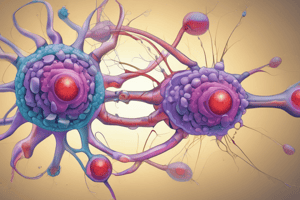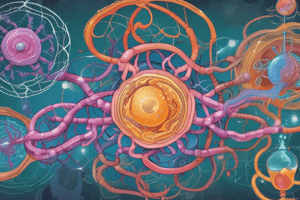Podcast
Questions and Answers
Which of the following statements about classical hormones is true?
Which of the following statements about classical hormones is true?
- They function as chemical messengers in the endocrine system. (correct)
- They are produced exclusively by the pancreas.
- They are secreted in large amounts to ensure effectiveness.
- They act on cells at a local level without entering the bloodstream.
What distinguishes endocrine signaling from synaptic signaling?
What distinguishes endocrine signaling from synaptic signaling?
- Endocrine signaling requires direct contact between cells.
- Endocrine signaling relies on the bloodstream and acts over longer distances. (correct)
- Endocrine signaling is faster than synaptic signaling.
- Endocrine signaling occurs only in the brain.
Why must hormones act at very low concentrations in the bloodstream?
Why must hormones act at very low concentrations in the bloodstream?
- They only function effectively in higher concentrations.
- They get greatly diluted in the bloodstream and interstitial fluid. (correct)
- They are highly concentrated due to their small volumes.
- They are immediately degraded in the blood.
Which of the following best explains the affinity of target cell receptors for hormones?
Which of the following best explains the affinity of target cell receptors for hormones?
Which of the following is NOT considered a classical hormone producer?
Which of the following is NOT considered a classical hormone producer?
Which characteristic is NOT associated with endocrine hormones?
Which characteristic is NOT associated with endocrine hormones?
Which statement correctly describes the relationship between hormones based on their interaction effects?
Which statement correctly describes the relationship between hormones based on their interaction effects?
What distinguishes neurotransmitters from neurohormones?
What distinguishes neurotransmitters from neurohormones?
Which of the following classes of hormones is synthesized from cholesterol?
Which of the following classes of hormones is synthesized from cholesterol?
Which class of hormone is primarily composed of amino acids and acts on receptors located on the cell surface?
Which class of hormone is primarily composed of amino acids and acts on receptors located on the cell surface?
How do antagonistic hormones function in the body?
How do antagonistic hormones function in the body?
What distinguishes steroid hormones from peptide hormones in terms of their synthesis and release?
What distinguishes steroid hormones from peptide hormones in terms of their synthesis and release?
What is a key mechanism by which steroid hormones exert their effects inside target cells?
What is a key mechanism by which steroid hormones exert their effects inside target cells?
How do peptide hormones differ from amino acid hormones in terms of their size and storage properties?
How do peptide hormones differ from amino acid hormones in terms of their size and storage properties?
Which statement correctly describes the action of amino acid hormones like epinephrine?
Which statement correctly describes the action of amino acid hormones like epinephrine?
What role does Hsp90 play in the mechanism of steroid hormone action?
What role does Hsp90 play in the mechanism of steroid hormone action?
What is the defining characteristic of the endocrine system compared to other forms of cell communication?
What is the defining characteristic of the endocrine system compared to other forms of cell communication?
Which of the following correctly describes the specificity of paracrine signaling?
Which of the following correctly describes the specificity of paracrine signaling?
What does the Greek origin of the word 'endocrine' signify?
What does the Greek origin of the word 'endocrine' signify?
What common property do all hormones in the endocrine system share regarding their effects?
What common property do all hormones in the endocrine system share regarding their effects?
Which class of signaling is characterized by messages transmitted directly between nearby cells?
Which class of signaling is characterized by messages transmitted directly between nearby cells?
Flashcards
What is the endocrine system?
What is the endocrine system?
The endocrine system is responsible for producing and releasing hormones into the bloodstream, where they travel to target cells and exert their effects.
What are hormones?
What are hormones?
Hormones are chemical messengers produced by endocrine glands and released into the bloodstream to affect target cells at distant locations.
How are hormones classified?
How are hormones classified?
Hormones are classified based on their chemical structure, including steroid hormones, peptide hormones, and amino acid derivatives.
How do hormones exert their effects?
How do hormones exert their effects?
Signup and view all the flashcards
How is hormone secretion regulated?
How is hormone secretion regulated?
Signup and view all the flashcards
Classical endocrine system definition
Classical endocrine system definition
Signup and view all the flashcards
What is a hormone?
What is a hormone?
Signup and view all the flashcards
Endocrine vs. Synaptic Signaling (speed)
Endocrine vs. Synaptic Signaling (speed)
Signup and view all the flashcards
Hormone Concentration and Target Cell Receptors
Hormone Concentration and Target Cell Receptors
Signup and view all the flashcards
Neurotransmitter Concentration and Target Cell Receptors
Neurotransmitter Concentration and Target Cell Receptors
Signup and view all the flashcards
What is a neurotransmitter?
What is a neurotransmitter?
Signup and view all the flashcards
What is a neurohormone?
What is a neurohormone?
Signup and view all the flashcards
What is a pheromone?
What is a pheromone?
Signup and view all the flashcards
How can hormones work synergistically?
How can hormones work synergistically?
Signup and view all the flashcards
How can hormones work antagonistically?
How can hormones work antagonistically?
Signup and view all the flashcards
What are steroid hormones?
What are steroid hormones?
Signup and view all the flashcards
What are peptide hormones?
What are peptide hormones?
Signup and view all the flashcards
What are amino acid hormones?
What are amino acid hormones?
Signup and view all the flashcards
What are intracellular receptors?
What are intracellular receptors?
Signup and view all the flashcards
What are second messenger systems?
What are second messenger systems?
Signup and view all the flashcards
Study Notes
BMN 1002 Cell Biology - Lecture 25: Introduction to Endocrinology
- Lecture focused on the introduction to endocrinology
- Recommended textbook: "The Endocrine System" by Joy Hinson, Peter Raven, and Shern Chew (2nd Edition) and "Human Physiology" by Dee Unglaub Silverthorn (4th Edition)
- Learning outcomes include defining the endocrine system and hormones, listing different hormone classes and their properties, explaining hormone action via receptors and feedback mechanisms regulating hormone secretion.
Mode of Communication
- Gap junctions: message transmitted directly between cells; specificity depends on anatomical location (e.g., heart).
- Synaptic: message transmitted across the synaptic cleft; specificity depends on anatomical location and receptors.
- Paracrine/Autocrine: message transmitted locally by diffusion in interstitial fluid; specificity depends on receptors.
- Endocrine: message transmitted by circulating body fluids (bloodstream); specificity depends on receptors.
Endocrine Glands and Hormones
- Endocrine glands produce hormones for both local and distant effects.
- Classical endocrine glands: pineal, hypothalamus, pituitary, thyroid, parathyroids, thymus, adrenals, pancreas, ovaries, testes
- Non-classical endocrine producers: kidney, heart muscle, adipocytes, endothelium, platelets.
- The endocrine system involves the release of hormones into the bloodstream acting on distant cells.
- Hormones are chemical messengers synthesized by specialized cells in small amounts to regulate cellular function in target organs.
Hormones, Receptors, and Actions
- Hormones act on specific receptors located on the cell surface or within the cell.
- High affinity: hormones are effective at low concentrations.
- Synergistic: two hormones have a greater combined effect than one alone.
- Permissive: presence of one hormone is necessary for another to have a full effect.
- Antagonistic: two hormones oppose each other's effects; hormones compete for the same receptor.
- Competitive: two hormones similar in structure compete for the same receptor.
Classifications of Hormones
- Hormones classified into three groups based on chemical structure:
- Steroids: synthesized from cholesterol; act on intracellular receptors, slow but long-lasting effects
- Peptides/Proteins: synthesized from amino acids; act on cell surface receptors.
- Amino acids: e.g., thyroid hormone; synthesized from tyrosine, variable mechanisms of action in the cell
Hormone Signaling-Peptide and Amino acid Hormones
- Action via second messengers like cAMP, IP3 pathways triggering rapid or long-term responses.
- Includes catecholamines, ACTH, FSH, LH, and others
- Mechanisms for hormone release include continuous (e.g., thyroid hormones), pulsatile (e.g., growth hormone), circadian (e.g., melatonin), and exocytosis on stimulus (e.g. insulin).
- Hormone activation includes structural alteration (e.g. vitamin D), degradation, receptor down-regulation, termination of intracellular effects, and negative feedback.
- Mechanisms of negative feedback involve the regulated metabolite (like glucose and insulin) , the hormone itself (like cortisol), and the trophic hormone from the pituitary.
Hormone Signaling-Steroid Hormones
- Steroids pass through the plasma membrane (lipid-soluble) and act on intracellular receptors, which bind to DNA and regulate gene transcription resulting in slow but long-lasting effects.
- Include examples like corticosteroids and sex hormones.
Action on receptors and 2nd messengers: Peptide and amino acid hormones : cAMP and IP3.
- Receptors have different signaling pathways depending on the hormones involved resulting in both short and long term effects
Mechanisms for hormone release, activation, and feedback control
- Feedback mechanisms regulate hormones ensuring homeostasis
Integrated and Complex Systems
- The hypothalamic-pituitary-axis forms the centre of the complex system for integrating hormonal functions involving both short and long-loop feedback systems.
Attempt questions in VEVOX during the session
Studying That Suits You
Use AI to generate personalized quizzes and flashcards to suit your learning preferences.




